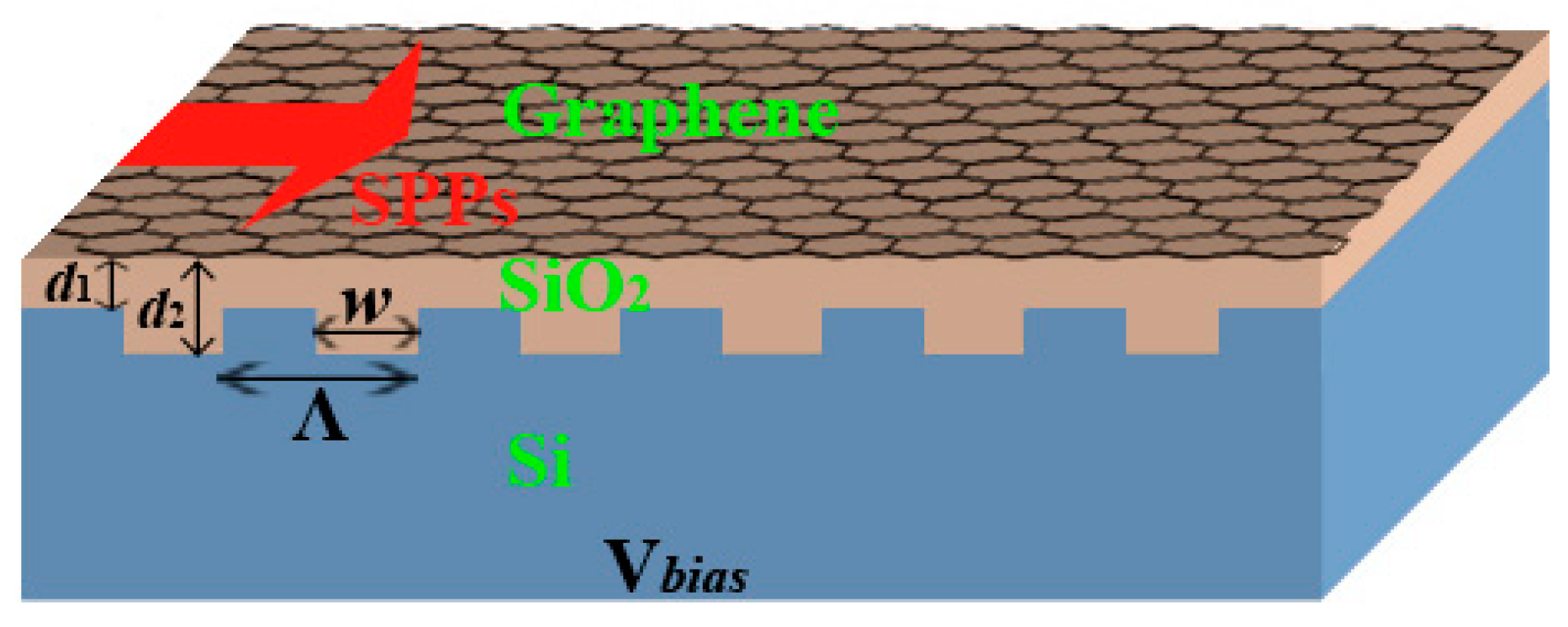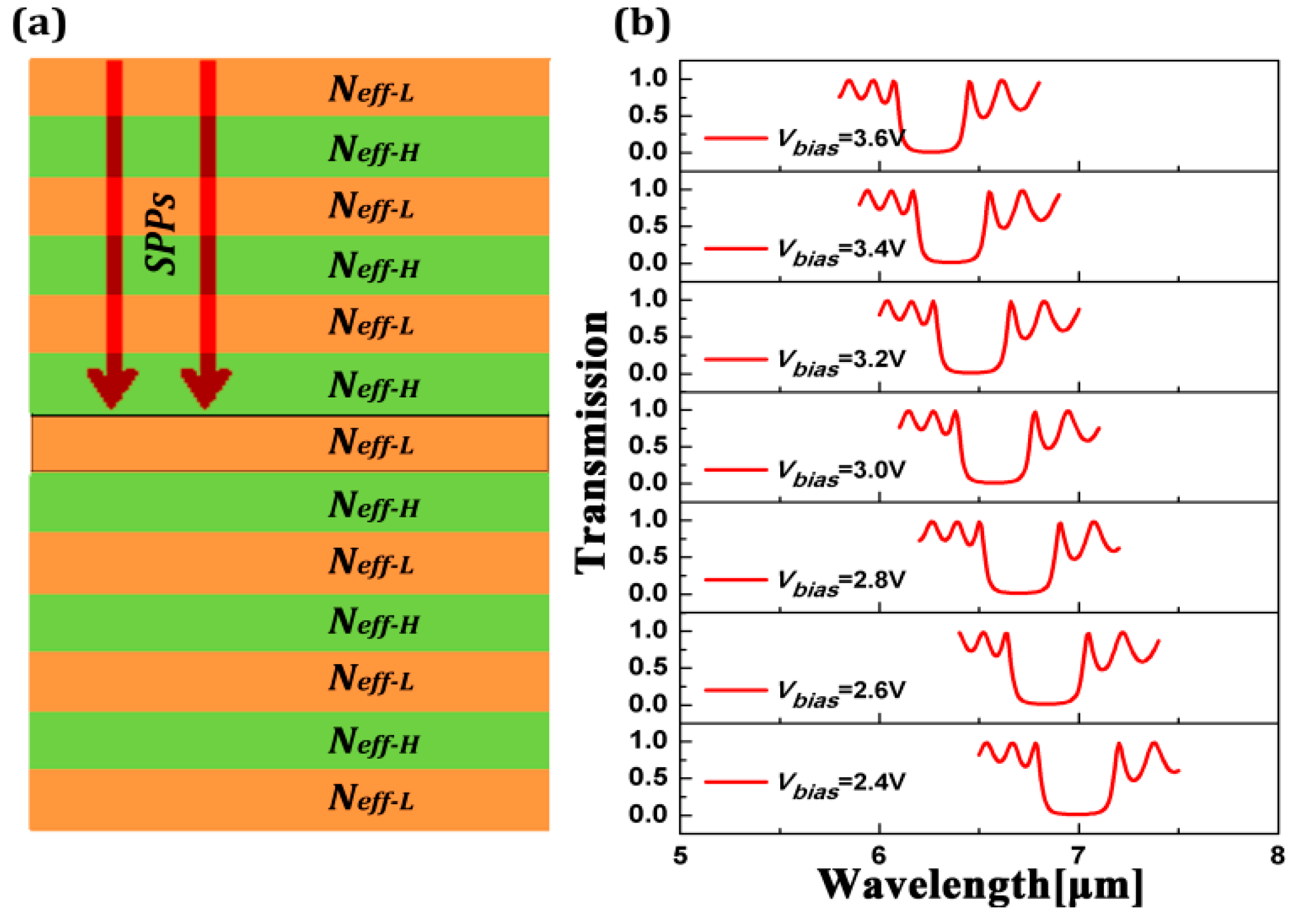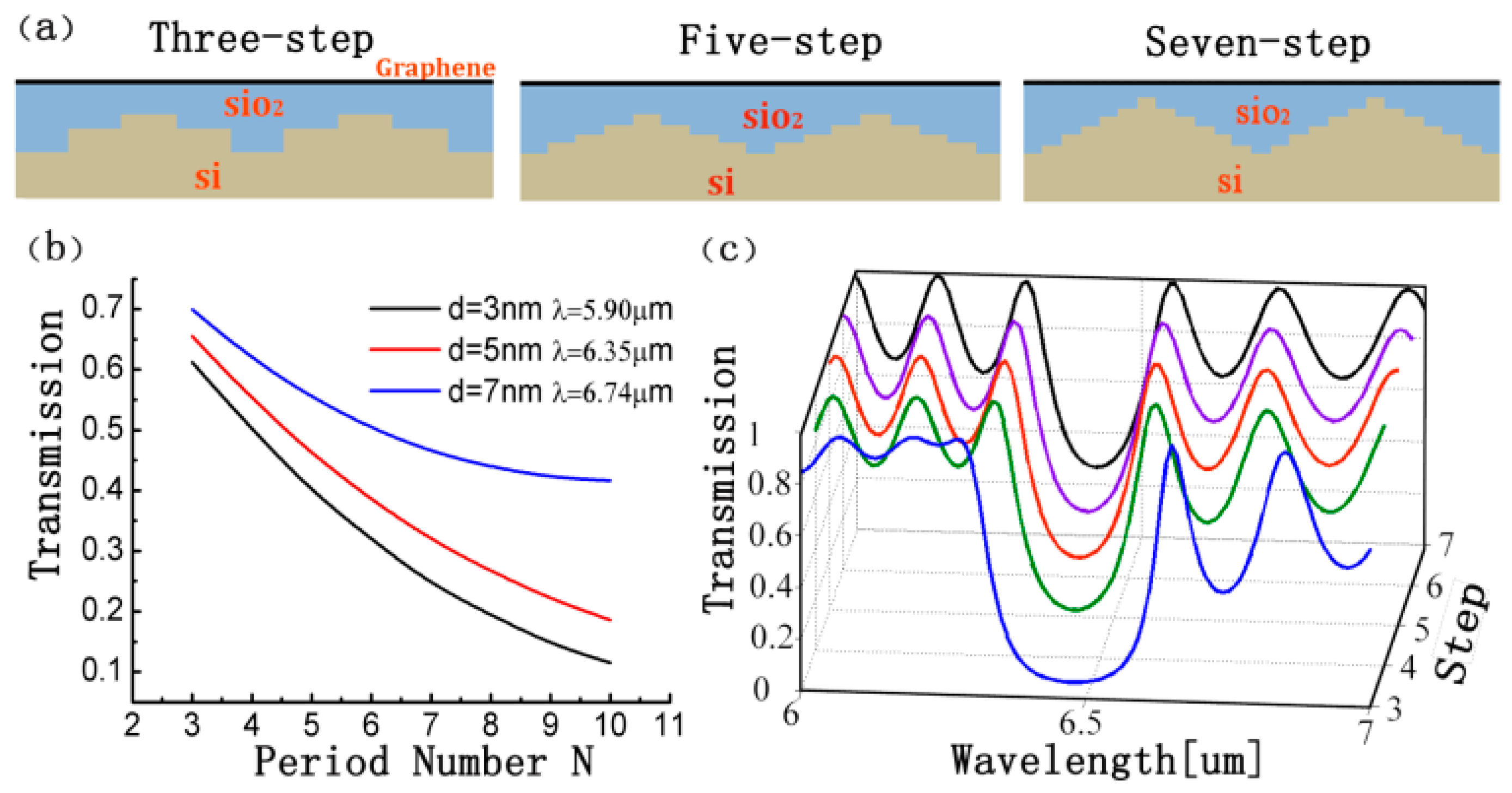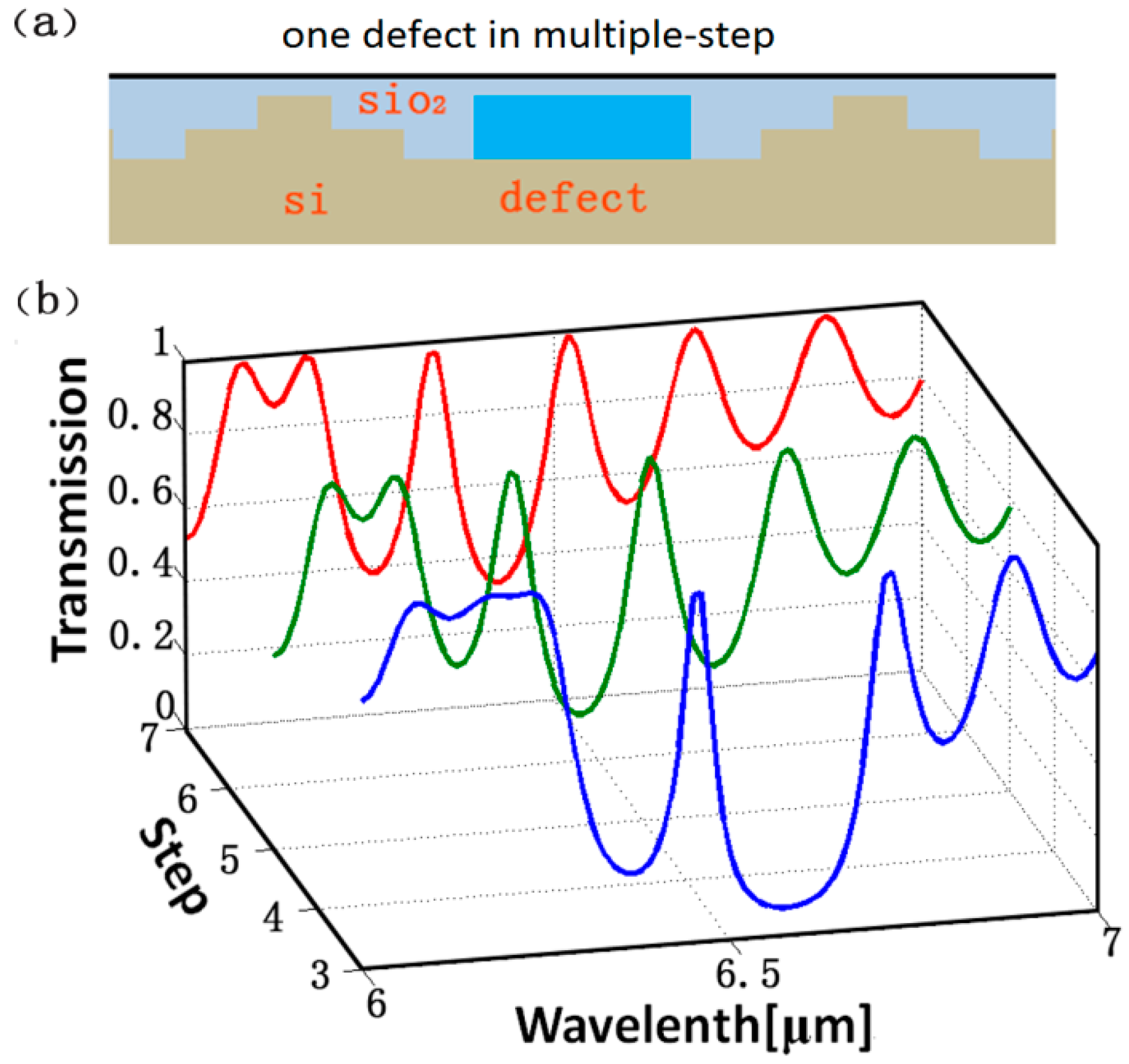Tunable Multiple-Step Plasmonic Bragg Reflectors with Graphene-Based Modulated Grating
Abstract
:1. Introduction
2. Model and Theoretical Analysis
3. Simulations and Results
4. Conclusions
Acknowledgments
Author Contributions
Conflicts of Interest
References
- Li, Z.Q.; Henriksen, E.A.; Jiang, Z.; Hao, Z.; Martin, M.C.; Kim, P.; Stormer, H.L.; Basov, D.N. Dirac charge dynamics in graphene by infrared spectroscopy. Nat. Phys. 2008, 4, 532–535. [Google Scholar] [CrossRef]
- Novoselov, K.S.; Geim, A.K.; Morozov, S.V.; Jiang, D.; Zhang, Y.; Dubonos, S.V.; Grigorieva, I.V.; Firsov, A.A. Electric Field Effect in Atomically Thin Carbon Films. Science 2004, 306, 666–669. [Google Scholar] [CrossRef] [PubMed]
- Geim, A.K.; Novoselov, K.S. The rise of graphene. Nat. Mater. 2007, 6, 183–191. [Google Scholar] [CrossRef] [PubMed]
- Polman, A.; Atwater, H.A. Photonic design principles for ultrahigh-efficiency photovoltaics. Nat. Mater. 2012, 11, 174–177. [Google Scholar] [CrossRef] [PubMed]
- Liu, M.; Zhang, X. Silicon photonics: Graphene benefits. Nat. Photonics 2013, 7, 851–852. [Google Scholar] [CrossRef]
- Wang, F.; Zhang, Y.; Tian, C.; Girit, C.; Zettl, A.; Crommie, M.; Shen, Y.R. Gate-variable optical transitions in graphene. Science 2008, 320, 206–209. [Google Scholar] [CrossRef] [PubMed]
- Fei, Z.; Rodin, A.S.; Andreev, G.O.; Bao, W.; McLeod, A.S.; Wagner, M.; Zhang, L.M.; Zhao, Z.; Thiemens, M.; Dominguez, G.; et al. Gate-tuning of graphene plasmons revealed by infrared nano-imaging. Nature 2012, 487, 82–85. [Google Scholar] [CrossRef] [PubMed]
- Brar, V.W.; Jang, M.S.; Sherrott, M.; Lopez, J.J.; Atwater, H.A. Highly confined tunable mid-infrared plasmonics in graphene nanoresonators. Nano Lett. 2013, 13, 2541–2547. [Google Scholar] [CrossRef] [PubMed]
- Lu, H.; Cumming, B.P.; Gu, M. Highly efficient plasmonic enhancement of graphene absorption at telecommunication wavelengths. Opt. Lett. 2015, 40, 3647–3650. [Google Scholar] [CrossRef] [PubMed]
- Wang, X.; Xia, X.; Wang, J.; Zhang, F.; Hu, Z.D.; Liu, C. Tunable plasmonically induced transparency with unsymmetrical graphene-ring resonators. J. Appl. Phys. 2015, 118, 013101. [Google Scholar] [CrossRef]
- Wang, B.; Zhang, X.; Vidal, F.J.G.; Yuan, X.C.; Teng, J.H. Strong coupling of surface plasmon polaritons in monolayer graphene sheet arrays. Phys. Rev. Lett. 2012, 109, 073901. [Google Scholar] [CrossRef] [PubMed]
- Liu, P.Q.; Luxmoore, I.J.; Mikhailov, S.A.; Savostianova, N.A.; Valmorra, F.; Faist, J.; Nash, G.R. Highly tunable hybrid metamaterials employing split-ring resonators strongly coupled to graphene surface plasmons. Nat. Commun. 2015, 6, 8969. [Google Scholar] [CrossRef] [PubMed]
- Atre, A.C.; Brenny, B.J.; Coenen, T.; Polman, A.; Dionne, J.A. Nanoscale optical tomography with cathodoluminescence spectroscopy. Nat. Nanotechn. 2015, 10, 429–436. [Google Scholar] [CrossRef] [PubMed]
- Deng, H.; Yan, Y.; Xu, Y. Tunable flat-top bandpass filter based on coupled resonators on a graphene sheet. IEEE Photon. Techn. Lett. 2015, 27, 1161–1164. [Google Scholar] [CrossRef]
- Wang, X.; Chen, C.; Pan, L.; Wang, J. A graphene-based Fabry-Pérot spectrometer in mid-infrared region. Sci. Rep. 2016, 6, 32616. [Google Scholar] [CrossRef] [PubMed]
- Chen, Y.; Song, Z.; Li, Y.; Hu, M.; Xing, Q.; Zhang, Z.; Chai, L.; Wang, C.Y. Effective surface plasmon polaritons on the metal wire with arrays of subwavelength grooves. Opt. Express 2006, 14, 13021–13029. [Google Scholar] [CrossRef] [PubMed]
- Chen, Y.; Zhang, Z.; Yu, M. Tunable out-of-plane slow light in resonance induced transparent grating waveguide structures. Appl. Phys. Lett. 2013, 103, 061109. [Google Scholar] [CrossRef]
- Lao, J.; Tao, J.; Wang, Q.; Huang, X. Tunable graphene-based plasmonic waveguides: Nano modulators and nano attenuators. Laser Photonics Rev. 2014, 8, 569–574. [Google Scholar] [CrossRef]
- Lu, H.; Zeng, C.; Zhang, Q.; Liu, X.; Hossain, M.M.; Reineck, P.; Gu, M. Graphene-based active slow surface plasmon polaritons. Sci. Rep. 2015, 5, 8443. [Google Scholar] [CrossRef] [PubMed]
- Tao, J.; Yu, X.; Hu, B.; Dubrovkin, A.; Wang, Q.J. Graphene-based tunable plasmonic Bragg reflector with a broad bandwidth. Opt. Lett. 2014, 39, 271–274. [Google Scholar] [CrossRef] [PubMed]
- Nesterov, M.L.; Abad, J.B.; Nikitin, A.Y.; Vidal, F.J.G.; Moreno, L.M. Graphene supports the propagation of subwavelength optical solitons. Laser Photon. Rev. 2013, 7, L7–L11. [Google Scholar] [CrossRef]
- Vakil, A.; Engheta, N. Transformation optics using graphene. Science 2011, 332, 1291–1294. [Google Scholar] [CrossRef] [PubMed]
- Gao, W.; Shu, J.; Qiu, C.; Xu, Q. Excitation of Plasmonic Waves in Graphene by Guided-Mode Resonances. ACS Nano 2012, 6, 7806–7813. [Google Scholar] [CrossRef] [PubMed]
- He, X.Y.; Li, R. Comparison of Graphene-Based Transverse Magnetic and Electric Surface Plasmon Modes. IEEE J. Sel. Top. Quantum Electron. 2014, 20, 4600106. [Google Scholar]
- Qu, S.; Song, C.; Xia, X.; Liang, X.; Tang, B.; Hu, Z.D.; Wang, J. Detuned plasmonic Bragg grating sensor based on defect metal-insulator-metal waveguide. Sensors 2016, 16, 784. [Google Scholar] [CrossRef] [PubMed]






© 2016 by the authors; licensee MDPI, Basel, Switzerland. This article is an open access article distributed under the terms and conditions of the Creative Commons Attribution (CC-BY) license (http://creativecommons.org/licenses/by/4.0/).
Share and Cite
Qian, Q.; Liang, Y.; Liang, Y.; Shao, H.; Zhang, M.; Xiao, T.; Wang, J. Tunable Multiple-Step Plasmonic Bragg Reflectors with Graphene-Based Modulated Grating. Sensors 2016, 16, 2039. https://doi.org/10.3390/s16122039
Qian Q, Liang Y, Liang Y, Shao H, Zhang M, Xiao T, Wang J. Tunable Multiple-Step Plasmonic Bragg Reflectors with Graphene-Based Modulated Grating. Sensors. 2016; 16(12):2039. https://doi.org/10.3390/s16122039
Chicago/Turabian StyleQian, Qinglu, Youjian Liang, Yue Liang, Hongyan Shao, Menglai Zhang, Ting Xiao, and Jicheng Wang. 2016. "Tunable Multiple-Step Plasmonic Bragg Reflectors with Graphene-Based Modulated Grating" Sensors 16, no. 12: 2039. https://doi.org/10.3390/s16122039
APA StyleQian, Q., Liang, Y., Liang, Y., Shao, H., Zhang, M., Xiao, T., & Wang, J. (2016). Tunable Multiple-Step Plasmonic Bragg Reflectors with Graphene-Based Modulated Grating. Sensors, 16(12), 2039. https://doi.org/10.3390/s16122039





